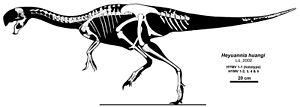Heyuannia
| Heyuannia | ||||||||||||
|---|---|---|---|---|---|---|---|---|---|---|---|---|

Skeleton reconstruction of Heyuannia huangi |
||||||||||||
| Temporal occurrence | ||||||||||||
| Upper Cretaceous ( Maastrichtian ) | ||||||||||||
| 72 to 66 million years | ||||||||||||
| Locations | ||||||||||||
| Systematics | ||||||||||||
|
||||||||||||
| Scientific name | ||||||||||||
| Heyuannia | ||||||||||||
| Lü , 2003 | ||||||||||||
Heyuannia was a theropod dinosaur from the group of oviraptorosauria who in the Upper Cretaceous of China lived. The only known species ( type species ) of this genus , Heyuannia huangi , was first described in 2003. Heyuannia , like other oviraptorosaurs, had a short tail and a deep, toothless jaw that was shaped into a beak. Presumably it was herbivorous or omnivorous . Within the Oviraptorosauria, Heyuannia is counted to the Oviraptoridae .
Find and naming
The finds come from a quarry near the village of Huangsha near Heyuan in the Chinese province of Guangdong . Stratigraphically , the late Cretaceous sediments of the site are counted as part of the Dalangshan Formation . The holotype material (catalog number HYMV1-1) consists of a partial skeleton with skull material, the arms and the rear caudal vertebrae being missing. Other bones are not counted in the holotype, but probably belong to the same individual: HYMV1-2 consists of an arm and the partial right shoulder girdle, HYMV1-3 consists of an incomplete right hand, HYMV1-4 consists of a partial hind leg and HYMV1-5 from a left hand.
Heyuannia is named after the city of Heyuan , around which the fossil was discovered. The specific epithet huangi honors Huang Dong, the director of the museum where the fossils are kept.
features
Heyuannia can be distinguished from other genera by various features ( autapomorphies ) on the skull and the residual skeleton; for example, the vertebral arches and ribs of the cervical vertebrae show foramia (openings). Heyuannia had more cervical and sacral vertebrae than any other oviraptorosaur, while the number of vertebrae was fewer.
Heyuannia was probably brood-tending and built open nests. Its eggs had a green-blue shell, similar to that of today's emus .
literature
- Junchang Lü: A new oviraptorosaurid (Theropoda: Oviraptorosauria) from the Late Cretaceous of southern China. In: Journal of Vertebrate Paleontology. Volume 22, No. 4, 2003, ISSN 0272-4634 , pp. 871-875. doi : 10.1671 / 0272-4634 (2002) 022 [0871: ANOTOF] 2.0.CO; 2
Individual evidence
- ↑ a b Jaime A. Headden: The New "Oviraptorosaurid" from China. In: Dinosaur Mailing List. Retrieved August 1, 2009 .
- ↑ J. Wiemann, T. Yang, PNN Sander, M. Schneider, M. Engeser, S. Kath-Schorr, CE Müller, PM Sander: The blue-green eggs of dinosaurs: How fossil metabolites provide insights into the evolution of bird reproduction. In: PeerJ . 3, 2015, p. E1323. doi: 10.7287 / peerj.preprints.1080v1